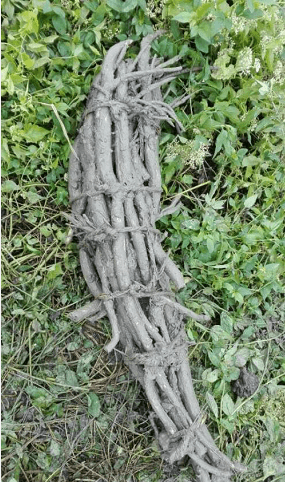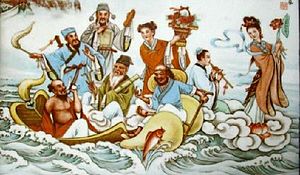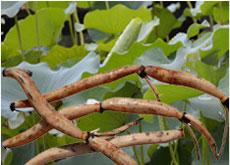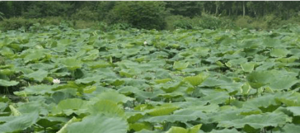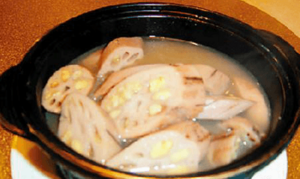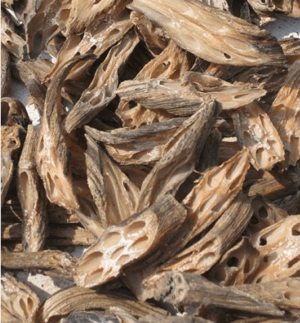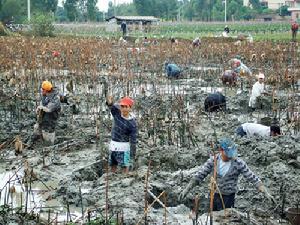Jingtang Lotus Roots facts for kids
The Jingtang Lotus Root (京塘莲藕) is a special water plant with pink flowers. It probably first grew in Jingtang, a place in Huadu District, Guangzhou City, Guangdong Province. People grew it for its roots and seeds. The root is the most common part eaten, but its green leaves are also tasty! This plant lives in water for many years. Its seeds can stay alive for a very long time if conditions are right. In fact, some lotus seeds found in China were 1,300 years old and still grew!
Contents
- A Look Back: History of the Jingtang Lotus Root
- Ancient Tales: The Legend of the Eight Immortals
- What it Looks Like: Appearance of the Jingtang Lotus Root
- How it Grows: Botany of the Lotus Plant
- Growing More: Production of Jingtang Lotus Root
- How We Use It: Usage and Health Benefits
- Keeping it Fresh: Storage Tips
- What Makes it Special: Distinct Features
A Look Back: History of the Jingtang Lotus Root
The Jingtang Lotus Root was first found over 800 years ago. It was discovered in a lotus pond. More than 1,000 villagers used to dig these roots out of muddy ponds by hand. This tradition still happens in Jingtang, Huadu, in northern Guangzhou. It's a local custom to start digging up lotus roots about seven days before the Dongzhi Festival (Winter Solstice) in the Chinese Lunar Calendar.
Ancient Tales: The Legend of the Eight Immortals
A long time ago, a legend says that the Eight Immortals visited an immortal named Xiangu. They were there to eat green litchi fruit. Suddenly, they felt a bad energy. Tieguai Li, one of the Immortals, smelled it and said, "There must be a sickness!"
The Eight Immortals looked around. They saw dry hills and cracked fields. Hundreds of villagers were starving. Some had fallen to the ground, while others tried to run away. The Immortals looked worried. Then, Tieguai Li smiled. "Don't worry, I have an idea!" he said. He took a special pill from his gourd, bit it, and spat. Rain began to fall! The dry hills and fields turned green, and the pond filled with water.
The villagers, who felt weak, rushed to the fields to gather wild plants. There, they met the Eight Immortals. Seeing them made the villagers feel calm. But Xiangu was still concerned. The villagers were thin and had no food. She remembered that the kind Avalokitesvara had given her some lotus seeds. Avalokitesvara had told her, "When you see humans suffering, you can throw these lotus seeds to help the world."
So, Xiangu quickly took the lotus seeds from her sleeves and threw them into a large pond. Soon, lotus flowers and leaves grew in the pond. The Eight Immortals' work was done. The next year, winter came, and the lotus leaves dried up. Experienced farmers knew this meant the lotus roots were ready. They led the villagers to dig up the roots and eat them. People believe that everyone who eats this lotus root becomes strong and healthy. This helped future generations to grow and thrive.
What it Looks Like: Appearance of the Jingtang Lotus Root
The sections of the Jingtang lotus root are thin. They are about 4 to 5 centimeters (about 1.5 to 2 inches) wide. Each small part can be about 40 centimeters (about 16 inches) long.
The overall shape is similar to a common lotus root. However, the Jingtang lotus root looks a bit different. When it's pulled from the pond, it looks rough, thin, and long. It's only a little thicker than a human thumb. It can grow to be more than 1 to 2 meters (about 3 to 6.5 feet) long, looking a bit like tree roots.
How it Grows: Botany of the Lotus Plant
Lotus roots grow in the soil at the bottom of ponds or rivers. Their large leaves float on the water's surface or stand tall above it. The beautiful flowers usually grow on thick stems. These stems rise several centimeters above the leaves. The leaves can be as big as 60 centimeters (about 2 feet) across. The showy flowers can be up to 20 centimeters (about 8 inches) wide.
Growing More: Production of Jingtang Lotus Root
In the past, the lotus pond was about 20 acres. It produced around 20,000 lotus roots. In late 2008, the village started an agricultural company. They made the pond much bigger, expanding it to 70 acres. This increased the planting area to 66,667 square meters (about 16.5 acres). With this larger size, the amount of lotus roots grown increased a lot. It rose to about five or six million kilograms (about 11 to 13 million pounds)! Lotus root stems are mostly water. When the water dries out during processing, the good nutrients inside become more concentrated.
How We Use It: Usage and Health Benefits
Lotus roots are often pickled. They are put in rice vinegar, sugar, chili, or garlic. They have a crunchy texture and taste sweet and tangy. In Asian cooking, lotus roots are popular in salads. They are often mixed with prawns, sesame oil, or coriander leaves.
Lotus roots are very good for you! They are full of dietary fiber and Vitamin C. They also have potassium, thiamine, riboflavin, Vitamin B6, phosphorus, copper, and manganese. Plus, they are very low in unhealthy saturated fat.
In Traditional Chinese Medicine, lotus roots have been used for many health issues. They have been shown to help with bleeding and other problems. Studies also show they can fight fungi, reduce swelling, lower fever, and help with anxiety. Recent research suggests that a substance in lotus roots called taurine has positive health effects. It can help reduce inflammation, protect brain cells, guard against diabetes, and help your immune system work better.
Keeping it Fresh: Storage Tips
If Jingtang lotus root is left out in the air, it will only last for 1 to 2 days. After being harvested, the lotus root quickly wilts, starts to decay, and turns brown.
What Makes it Special: Distinct Features
The Jingtang lotus root has three main features that make it different from common lotus roots.
First, the lotus root grown in these ponds is thin and long. Common lotus roots are usually thick and short.
Second, after the lotus root harvest in winter, people don't need to plant it again. As long as there is water, the lotus leaves will grow back every spring. The lotus root doesn't need much care, as long as it has a water source.
Usually, the lotus roots are owned by the whole village. Every year after the winter solstice, the village picks a day to harvest the lotus roots. The whole village joins in the harvest! The person who digs out a root gets to keep it. When digging, people don't use tools. This is because the lotus root is thin and long. Also, they grow deep in the mud. So, people must dig by hand to get the whole root out. The lotus root in the picture can be sold for a high price. So, villagers are very careful while digging. The longer the lotus root is, the more money it brings. On average, they grow to be one meter (about 3 feet) long. The longest lotus root ever found was two meters (about 6.5 feet) long and weighed four to five pounds!


